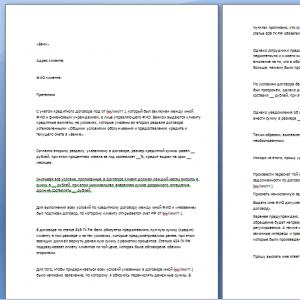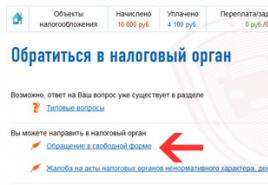State program to provide housing for young families. Conditions and benefits of assistance programs for young families
The federal program in its current version is designed for the period from 2016 to 2020. It was developed by order of the Ministry of Regional Development of the Russian Federation. As part of the federal Housing program, this subprogram is aimed at supporting young families officially recognized as in need of improving their living conditions.
This program:
- creates conditions for the effective implementation of the national project to provide affordable housing.
- operates on the territory of Russia as a whole and is a particularly important support for Russian citizens living in regions that have not yet adopted regional housing assistance programs for young families.
As part of the “Young Family” program, the state undertakes to pay at least 30% of the cost of housing for families without children, and 35% for families with children.
Conditions of the program and its goals
To participate in the Housing for Young Families program, all families must meet certain conditions:
- Age of each spouse (single parent) cannot be more than 35 years old.
- It is important that local authorities recognize the family as needing to improve its living conditions.
- The applicant must have his own family funds to pay the balance of the cost of housing.
The program provides the opportunity to:
- purchase of residential premises;
- payment for the construction of an individual residential building;
- making the last share payment for a housing construction or housing savings cooperative;
- payment of the initial mortgage payment in case of purchasing a home with a mortgage;
- repayment of a home loan (principal and interest).
It is now planned that in just 5 years it will be easier for about 157 thousand young Russian families to buy housing through participation in the program.
Required documents
To participate in the “Providing Housing for Young Families” project, applicants must contact the city administration - the Municipal Property Management Committee or the department that manages housing policy or works directly with young people.
The following documents should be collected:
- a copy of the applicant’s passport (copies of identification documents of all family members);
- an extract from the state register of rights to real estate and transactions with it (for each spouse);
- a certificate from the local government about the established accounting standard for the area of living space per family member;
- cadastral passport;
- certificate of registration at the place of residence;
- certificate of family composition;
- an extract from the house register, from the personal account for each family member;
- a certificate stating that the family is registered as in need of improved housing conditions;
- a copy of the child(ren)'s birth certificate;
- a copy of the marriage certificate.
In Russia, at the beginning of 2000, a policy was chosen to improve demographics in the country. In connection with this, federal authorities have developed a number of bills to support and encourage the birth rate. One of the directions of the state in this area was the adoption of housing programs.
What federal programs to provide housing for young families are currently in place?
Boys and girls who have tied the knot, first of all, are wondering about the housing issue and the availability of financial resources to purchase this housing. The problem is especially aggravated when a “newly made” family is expecting a new addition.
Any parent understands that a child should grow up and be brought up in comfortable conditions in their own home, and not be afraid of a situation when the landlord may ask to vacate the living space rented by the spouses (or occupied under other conditions).
Also, the full development of a child, primarily in an emotional state, cannot take place, for example, in a one-room apartment in which several people live.
Thus, the Government of the Russian Federation has developed and adopted programs to support young families in the field of improving housing conditions:

- providing ;
- state program “Housing”;
- state program “Increasing the sustainability of residential buildings, main facilities and life support systems in seismic regions of the Russian Federation for 2009–2018.”
Decree of the Government of the Russian Federation No. 1243 of October 12, 2017 introduced some changes that became effective from January 1, 2018. Namely, “Housing” 2015-2020. and the program concerning seismic areas ceased to operate.
They were replaced by: “Mortgage and rental housing”, “Ensuring the quality of housing and communal services”. These subprograms became part of the project “Providing affordable and comfortable housing and utilities for citizens of the Russian Federation,” which regulates, among other things, the living conditions of young spouses.
Conditions of the Young Family program
State assistance to young families dates back to 2002 with the law on providing housing for young families, which has been adjusted and modified over time.
Thus, until 2006, one of the mandatory conditions for receiving a subsidy was the presence of at least one child (natural or), and until 2008, persons under 30 years of age were recognized as “young”. State assistance under the new state program consists of a free targeted payment of part of the funds to a “young family” to improve their living conditions.
The amount of payment is regulated by a specific entity, but it cannot be less than that established at the federal level:

- 30% of the average cost of housing - for married couples who do not have natural or adopted children;
- 35% - for two-parent families with one or more children, for single-parent families with children ().
The money transferred within the framework of this program can be used only for certain purposes: repaying the first mortgage payment, paying a share contribution, adding to one’s own funds and purchasing residential premises under a sales contract, repaying a loan taken to resolve the housing issue.
In this case, the subsidy is issued according to clearly established standards: 42 sq.m. for 2 people, 18 sq.m. for each member of a family consisting of 3 or more persons. Not all young people have the right to improve or purchase housing with government funding.
The law prescribes a number of conditions for persons, subject to which participation in this federal project is possible:
- the age of each spouse cannot exceed 35 years, both at the time of submitting documents and specifically at the stage of signing the state document. organs;
- must have at least 1 minor child;
- presence of registration in one living space of all family members;
- Russian citizenship of at least one of the spouses;
- the possibility of repaying a sum of money not included in the subsidy from personal savings, or the availability of funds to repay a loan taken for this purpose;
- recognition of a family as in need of improved housing.
According to Article 51 of the Housing Code of the Russian Federation, in order for a family to be recognized as needy, one of the mentioned factors must be present:
- lack of housing ownership or under a social rental agreement;
- discrepancy between the established footage of the living space and the number of family members (small area);
- the housing in which the spouses currently live is recognized as unsafe, dilapidated, or located in a place hazardous to health;
- family members live with a person who, for health reasons and medical reasons, must be provided with separate accommodation.
List of required documents
Provided that the young family meets all the necessary requirements for participation in the program, the following package of documents is submitted to the housing department of the district administration along with the application for a subsidy:

- passports and) all family members;
- — for complete families;
- certificate of recognition as needing improved housing conditions;
- income certificates;
- bank account details.
To repay the mortgage, you must additionally submit:
- mortgage agreement;
- the amount of money outstanding;
- an extract confirming ownership of the property.
This list is not final, as it may be expanded in the regions. For example: (if used), a military serviceman’s ID card, a certificate of family composition, copies of work records.
The package of documents should be submitted in the first half of the coming year due to the fact that the list is formed before June 1, and at the regional level this period may be reduced.
The application is reviewed within 10 days, after which the young family is either approved for state assistance in improving their living conditions or denied. The decision will be notified within 5 days.
If the answer is positive, financial assistance will only be available next year by joining a waiting list. Other people in need of assistance are also considered priority.
Regional features
Subjects of the Russian Federation that took part in the implementation of the federal program to provide young families with living space have the right, at their own discretion, to independently change some details of the law, based on the established federal minimum standards.
Regional authorities have the right to change the monetary amount of payments, add to the list of documents, expand the list of persons eligible for subsidies, and set the minimum income of participants to qualify for the program:
- Altai region. The size of the housing payment is at least 30% of the average cost of housing (ACH) for persons without children and 45% for the construction of a house. 35% - for single-parent families or families with children, 50% - for home use;
- Bryansk city. 60% - without children, 65% - with children or one parent and child/children;
- Vologda Region. A fixed cash payment is established here: 200,000 rubles for one young spouse + 100,000 rubles for each child;
- Ivanovo, Magadan regions, Republic of Mordovia. 30% - for families without children, 35% - spouses with children or single parent and children;
- Kaluga region. In addition to the standard payments established at the federal level, it is additionally provided: +5% for 1 child, +7% of the minimum wage for the 2nd child, +10% for each subsequent child (including adopted ones);
- Novosibirsk, Pskov regions,. 30% - for “childless” parents, 35% - two-parent families and single parents with children. In the period from the date of issue of the certificate of receipt of the subsidy until the moment it is credited to the bank account - at the birth of a child +5%.
According to statistics, the majority of adult Russians are interested in purchasing housing. In this regard, a state target housing program was developed in 2011. It consists of paying subsidies to young families wishing to purchase housing. Valid in all constituent entities of the Russian Federation.
Main goals of the program
Social support for the population is designed to provide citizens with comfortable housing on favorable terms. The subsidy consists of partial (30-40%) repayment of the cost of the purchased property through mortgage lending. The exact numbers depend on the preferential category and the specific region.
This program was officially approved by Russian government decree No. 1050. In 2016, amendments were made through Resolution No. 855.
The main goal of this program is to provide citizens with housing on favorable (preferential) terms for them. With the growth of purchasing power (government subsidies motivate those who previously did not have such an opportunity to purchase real estate), the volume of residential construction increases.
This goal is due to the fact that in the first decade of the 21st century there has been a shortage of housing stock in the country. Despite the large number of mortgage lending offers, many working citizens simply do not have the opportunity to pay such substantial monthly payments.
Support for the population in purchasing housing should improve the standard of living in the country as a whole, especially for privileged categories of citizens. These, in addition to young families, include internal affairs workers, scientists, rescue workers, and retired military personnel (according to length of service).
Adjustments for the period 2016-2020
5 years after the creation of this program, certain changes were made to it, namely:
- Secondary housing has become more affordable. Until recently, this range of real estate was considered excessively expensive. The introduced benefits make it possible to reduce the rate on secondary mortgage lending to 10-11% per annum.
- The maximum housing price has been increased. For the regions - 4 million rubles, for Moscow and St. Petersburg - 10 million. Thanks to this, the number of people wishing to participate in the program should increase.
- The list of citizens for whom participation is available has been adjusted (conditions are presented below).
- Mortgage lending has been introduced for individual housing construction (private low-rise construction). The maximum limit is 3 million rubles. at an annual rate of no more than 10.5%.
Conditions of participation 2016-2020 for young families
The conditions for participation in the federal Housing program from 2016 to 2020 are as follows:

Important: the program laureate must not own housing that meets all standards.
If a person belongs to a special preferential category (disabled people, large families, veterans, etc.), more favorable subsidies are optimal for him, up to the provision of free housing.
How and where to contact
In order to become a participant in the Housing program, you must come to the local administration with an application before September 1. Filled out in 2 copies.
You will also need to provide the following list of documents:
- Russian Federation passports for all family members. If they are not available, a military ID, driver's license or similar document.
- Birth certificates for minor children (if available).
- Marriage certificate.
- Certificates confirming income (NDFL-2). In this case, official employment is required; the program does not yet apply to self-employed persons.
- A bank statement stating that the person has in his account the amount required to make a down payment (10% of the price of the property).
- Certificate of living conditions.
Administration staff will review the documents and issue a verdict. If the decision is positive, the amount of the state subsidy will be calculated. Based on this, the person will be issued a certificate to receive funds.
Then, within 2 months (the validity period of this certificate), the person must contact the bank and enter into a mortgage loan agreement, providing the received certificate. A citizen has 9 months to purchase an apartment.
Video about the implementation of the program
If you receive a subsidy, a person will need to report on the funds spent after purchasing real estate. This is how the government prevents the possibility of fraudulent schemes.
The federal Housing program, developed in 2002, has still not lost its relevance. It allows citizens of different categories to improve living conditions for their families.
Let's look at what has been done during this time. How to get a subsidy for a house? How did the conditions for participants change?
Description of the state program “Housing”
What do participating citizens get?
 Buying a home is an expensive proposition that is beyond the reach of most young people. Participation in state program events increases the chance of citizens to purchase their own apartment.
Buying a home is an expensive proposition that is beyond the reach of most young people. Participation in state program events increases the chance of citizens to purchase their own apartment.
The state will pay part of the funds for them, and the rest will be given on credit. The loan, according to the documents, will be preferential. It provides for rates of 10-12%. This is currently almost half what banks are offering.
The state expects to finance from 30 to 40% of the cost of purchasing a house or apartment. Specific numbers depend on the preferential category and other starting conditions. However, the program participant is required to prove his own solvency. All the money won't pay for it.
The estimated value of the property is taken into account, not the market value.
It is envisaged that part of the loan provided under the state program will be repaid from maternity capital funds.
Do you need information on this issue? and our lawyers will contact you shortly.
What goals does the state set for itself?
The government has a responsibility to develop all areas of the economy while taking care of vulnerable people. The state program “Housing” meets these criteria. Its goals are manifold.
They are briefly stated in the documents as follows:
- To create favorable conditions for the development of the construction sector, in terms of creating energy-efficient and environmentally friendly housing.
- Ensuring that the standard of living of Russians is raised.
- Solving the housing problem of vulnerable categories of citizens.
- Fulfillment of the state's social obligations.
- Organization of joint work of federal and local authorities to develop the infrastructure of cities and villages.
Particular attention in the events is paid to beneficiaries. The priority categories of citizens, except for youth under 35 years of age, are:
- military personnel who retired due to length of service;
- police officers;
- prosecutor's office;
Investigative Committee; - scientists;
- liquidators of the accident at the Chernobyl nuclear power plant;
- rescuers.
By decision of the President of the Russian Federation, the list of beneficiaries may be expanded or adjusted.
The documents are talking about economy class houses and apartments!
Main criteria for selecting participants
Only citizens of the Russian Federation can apply for a subsidy. The state program applies to young people under the age of 35.
The potential participant will be required to make a down payment on the house.
Its size is fixed. It is 10% of the appraised value of the property. Therefore, the applicant must have such amount.
The government does not handle cash. The required 10% should be deposited into a bank account.
In addition, specialists will check whether the FTP participant will be able to repay the soft loan. And this presupposes a stable family income, which must be documented.
Where to contact potential participants
Having decided on his intentions, the young man must come before September 1 to the administration of the city (town, village) in which he lives. Applications for participation in the state program “Housing” are accepted only until this date.
Citizens who will not turn 35 before November 1 can apply this year.
In addition, you must have the following documents with you. Applications are reviewed on a commission basis. The government agency is obliged to respond to the applicant within 10 days. The period is counted from the date of submission of the application.
Frequently asked questions about participation in the program
The documents indicate that the events are designed for young families. However, an application can be submitted by a single person who falls within the restrictive age criteria. According to the Family Code, he is also a separate unit of society.
It is important to have time to decide on your intentions before the age of 35.
What to do if the husband or wife is over 35 years old? In this case, the second spouse can apply. If all criteria regarding finances and other conditions are met, the family will receive state assistance.
The main condition for participation in the program is the age of the applicant. In this case, the criterion does not apply to the second spouse.
Required documents
 When going to the local administration, you should stock up on certificates and do not forget your identification documents.
When going to the local administration, you should stock up on certificates and do not forget your identification documents.
The receiving specialist will ask you to fill out an application form. This is done in 2 copies. It is not recommended to write it in advance, since the application must correspond to the established template (they will be given on the spot).
The task of the applicant for a soft loan is to collect the papers in full.
These include the following:
- identification documents of all family members (and copies thereof);
- marriage certificate (for official social units);
- income certificates for all employees (official employment only);
- confirmation of the availability of 10% of the cost of the house (from the bank);
- certificate of living conditions.
Action plan
Here is an algorithm of what potential applicants for a subsidy should do.
- Collect the above documents.
- Calculate your income. Only part of the money, approximately half, should be used to repay the loan. The specialist will ensure that the family is not left without funds after committing to participate in the program.
- Write a statement to your local administration. Its essence is that the family needs improved living conditions.
- Confirm the availability of the amount for the down payment.
- Get a calculation of the amount of the subsidy in accordance with current legislation.
- Wait for a positive decision from the commission.
- Issue a certificate for a subsidy for the construction (purchase) of housing.
- Take the above document to a banking institution (two months are given for this).
- Conclude a loan agreement with the bank, open an account, find out what documents should be submitted to the bank to use the funds.
- Buy an apartment within 9 months.
- Report on the expenditure of funds.
Results achieved
It is too early to say that the main goals of the state program “Housing” have been achieved. The cost of apartments and houses did not decrease, nor did the percentage of young families with satisfactory housing conditions.
Nevertheless, there are some successes. So:
- the share of private housing among Russians is gradually increasing;
- mortgage lending is developing;
- the volume of commissioned housing stock is growing;
- The infrastructure of cities is being modernized through the use of budget funds and citizens.
The maximum amount of a preferential loan is 3 million rubles, and in the capital and St. Petersburg - 8 million rubles.
Last modified: January 2019
- a conventional term. It refers to a set of various social measures aimed at helping citizens solve their housing problems. The name of the program eloquently shows that its target category is young people who have entered into an official marriage. The demographic well-being of the country depends on them, and the state is ready to support such families. Especially when spouses decide to have children.
Demographic problems in Russia began a long time ago. That’s why the Young Family program has a long history.
- In 2002, the “Providing Housing for Young Families” project was launched, which lasted until 2010.
- Until 2006, within the framework of it, state support in the form of cash subsidies was provided only after the birth of a child to spouses or its adoption.
- Then the program was adjusted. The appearance of a baby in a family began to be considered not as a mandatory condition for the state to subsidize the purchase of housing, but as an additional “bonus” for the implementation of this project. It was assumed that solving the housing problem would motivate many spouses to add to the family.
- Until 2008, a husband and wife were considered “young” until they reached 30 years of age. But then the age limit was increased - to the 35th anniversary of the spouses.
- Since 2010, the “Providing Housing for Young Families” program has changed somewhat. Its priority participants also included families recognized as needing improved housing even before 2005. Subsidies were replaced with targeted social payments, which were allowed to be spent only on the purchase of family real estate.
Initially, the project “Providing housing for young families” was designed until 2020 inclusive. But last year it was completed ahead of schedule. And since 2018, a new state support program has been running for young spouses who have housing problems.
What program is currently in effect?
In 2019, state support is provided to young families within the framework of a government project called “Providing affordable and comfortable housing and public services to citizens of the Russian Federation.” It focuses on making mortgage lending and rental housing easy for borrowers. Program activities are planned until the end of 2025.
The new project has several goals. One of them is a significant reduction in the cost of residential premises, so that almost any young family (and other preferential categories specified in the document) can not only acquire real estate, but also regularly improve its quality - once every 15 years. To achieve this, in particular, the price of an average two-room apartment (54 sq.m.) by 2025 should be 2.3 times the total annual income of a family of three people. That is, if, for example, after 8 years a wife, husband and child live on 50,000 rubles a month, or 600 thousand a year, they should have the opportunity to purchase living space for 1 million 380 thousand rubles.
Other goals of the government program are:
- activation of the construction market;
- providing citizens with higher quality public services;
- increasing labor productivity in the construction industry.
What does the state promise?
For program participants, including young families, the state is ready to provide cash payments for the construction or purchase of housing. Its exact size is determined by the regions, but the federal government has determined its minimum value, which local authorities are required to take into account:
- 30% of the average cost of residential real estate - for married couples who do not have natural or adopted children;
- 35% of the average cost of housing:
- for families raising one or more natural/adopted children;
- for single-parent families with children (where there is only one parent).
The average cost will be calculated using the formula:
local cost standard 1 m 2 * size of purchased/constructed housing.Money received from the state is allowed to be spent:
- for deposit;
- to pay a share contribution;
- for partial payment of the cost of residential real estate purchased under a regular purchase and sale agreement;
- for payment for work on building a house - under a construction contract;
- to repay the main “body” of the loan and interest on the loan, if it was taken out to solve a housing problem.
You should not expect that budget funds can pay off a third of the expenses for any residential premises.
The state will strictly monitor its size and subsidize only clearly established standards:
- 42 m2– for young spouses without children or one parent with a child;
- 18 m2– for each member of a family consisting of three or more household members (including 1 parent and several children).
Conditions of the Young Family program
Young families are eligible to participate in the housing program if they meet certain criteria:
- the age of the spouses or single parent does not exceed thirty-five years - and not at the time of submitting documents, but on the day officials make a decision on their participation in this social project;
- young spouses (single parents) have:
- or a sufficient amount of their own savings with which they can pay the seller - in the amount of the cost of housing not covered by payments from the state;
- or significant regular income that will allow them to take out a loan for these purposes;
- one of the spouses or the only parent in the family must have Russian citizenship;
- the family was officially recognized as in need of housing.
Let us remind you that in order to recognize such a need, you will need to document one of the following circumstances (Article 51 of the Housing Code):
- That the applicants do not have any housing at all - neither owned nor under a rental agreement.
- That the housing they occupy is too small - the minimum standard established by the state is not observed.
- That the living space a young family has is not suitable for permanent residence - for example, it is in dilapidated or disrepair, or is located in an area with a high concentration of substances harmful to the body.
- That a married couple is forced to live together with a seriously ill person, who by law must be provided with a separate living space.
Package of documents
An approximate list of documents required to be included in the list of program participants is as follows:
- the corresponding application is on a special form;
- identification documents of all members of the young family - passports, children's certificates (copies are provided, but the originals should be taken with you);
- marriage certificate, if a complete family wishes to become a participant in the program (a copy is provided);
- a certificate from the social security authority that applicants for participation in the project are recognized as in need of housing;
- certificates of family income (2-personal income tax, bank account statements, etc.);
- Bank details – for transferring the amount of money.
If, with the help of a state cash payment, a family intends to repay part of the mortgage loan, then the following are additionally provided:
- loan agreement with the bank;
- a certificate of the amount (balance) of the debt outstanding by the debtor;
- extract from the Register - on registration of ownership of mortgaged real estate.
This list of required documents is established by Government Decree No. 1050 of December 17, 2010. However, it cannot be called exhaustive, since locally, other documentation is often included in the required package. Additional papers may include:
- military serviceman's ticket;
- work books of able-bodied family members;
- (form-9);
- (if the family plans to involve him in solving the housing issue), etc.
The application and documents are submitted to the local administration or multifunctional center. The validity of the demand and the authenticity of the papers submitted by citizens are checked by officials within 10 days, after which they make a decision:
- or the inclusion of a family in the program;
- or refusal to do so.
Applicants are informed of any of these decision options in writing. The administration’s refusal to include them in the program must be motivated and explained. The notice is sent to the filer at within 5 days after a positive or negative decision has been made regarding it.
 Detailed conditions of the program to help young families are developed at the level of regional legislation. Despite the fact that this project was developed at the federal level, the constituent entities of the Russian Federation co-finance housing payments provided to citizens.
Detailed conditions of the program to help young families are developed at the level of regional legislation. Despite the fact that this project was developed at the federal level, the constituent entities of the Russian Federation co-finance housing payments provided to citizens.
Their task is to comply with the minimum standards established by the central government. For the rest, they proceed from the capabilities of the local budget, as well as their own understanding of the conditions and in what order they can receive the state one. In particular, they have the right to adjust:
- amount of payment;
- list of documents provided by applicants for participation in the program;
- categories of persons entitled to housing subsidies;
- minimum income of program participants.
Not all Russian regions are included in the project. And those who joined it took on very different obligations that were within their power. This, in particular, can be seen from the table presented.
| Russian region-participant | Housing payment amount | Where to submit documents |
| Altai region | Not less: 35% of SJ – married couple or single parent with child/children (50% - for building a house) |
Local government - at the place of permanent residence of the young family. |
| Bryansk | Not less: 60% of the SSL – for “childless” program participants; 65% of the SSL is for families with children (including single-parent families). |
District administration Bryansk - at the place of registration of one of the applicant spouses. |
| Vologda Region | 200,000 rubles – to a childless family. + 100,000 rubles – for each existing child. |
Regional Department of Construction and Housing and Communal Services. |
| Ivanovo region Magadan Region The Republic of Mordovia |
35% from SJ – a married couple or a single parent with a child/children. |
The authorized body is in the municipalities of the region/republic. |
| Kaluga region | In addition to the standard payments provided for by the program, additional payments to young parents are provided from the regional budget: 5% of the SSJ - for the 1st child; 7% of the lifespan – for the 2nd child; 10% of the SSL – for each subsequent child (including adopted children). |
The authorized body is at the municipalities of the region. |
| Novosibirsk region Pskov region Republic of Tatarstan |
30% of the life insurance premium – for young spouses without children; 35% of households - a married couple or a single parent with a child/children; 5% additionally - at the birth of a child (from the date of issue of the certificate of entitlement to payment until it is transferred to a bank account). |
Local government body at the place of residence of the young family. |
- Read also about: (full list).
- Information may be useful for holders of a maternity capital certificate: .
Do you have any questions about this topic? Ask our lawyer using the form below or call the numbers below.

Do you have questions or clarifications? Our specialists are happy to help you. If you need legal advice over the phone, you can order a call back using the online consultant form, and our specialist will call you back at a convenient time.







